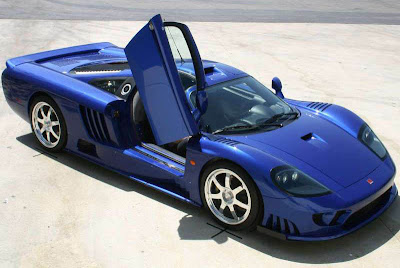Saleen knows all about power. As in S281 Mustangs, N2O Focuses and the S7, America's first (and still the only) mid-engine exotic supercar. When it went on sale in 2002, the S7 was the only street-legal car in the U.S. with more than 500 horsepower and 500 lb-ft of torque. The media and S7 owners have raved about the car since it first smoked the rear tires in anger. And it has been recognized by numerous automotive magazines as the fastest production car in the world.
But during the past three years the automobile marketplace has witnessed an explosion of performance with models from manufacturers including Ferrari, Lamborghini, Mercedes-Benz, Porsche and Chevrolet touting power numbers above the once magic 500 level.
 What's New for 2005
What's New for 2005
It was pretty obvious to Saleen product planners during the late 1990s that horsepower and torque numbers were trending upwards, especially among the purveyors of supercars. And power figures that looked spectacular at that time might seem quite ordinary a few years down the road. So Saleen engineers have been planning for this day since they drew the first line on a computer screen for the original S7's 7-liter engine.
Engine & Drivetrain
Designed by Saleen engineers, the S7's engine and drivetrain incorporate the latest in modern racing technology. The new all-aluminum V8 engine casting was engineered and tooled by Saleen to displace seven liters. Redline is 6500 rpm. Space age materials and engineering are used throughout, including stainless steel valves, titanium retainers, beryllium exhaust valve seats, an aluminum throttle body, Saleendesigned aluminum CNC-machined cylinder heads and stainless steel exhaust system.
The four exhaust pipes from each bank of cylinders merge into a race-car-like high-efficiency collector. In addition, the exhaust incorporates dual catalysts per cylinder bank, EGR and those aforementioned twin wastegates. And because Saleen believes in power and clean air, the emission control system features dual, heated oxygen sensors per cylinder bank and a high-volume evaporative emission system along with those four catalysts. Oh, and for good measure and clean air, the system is OBD-II compliant.
A Saleen PowerFlashTM performance computer, recalibrated for 2005, handles engine management. The ignition system is integrated coil-on-plug.
A new-generation six-speed transaxle, with a unique Saleen bell housing, transfers power to the wheels. The clutch is an organic/metallic 8.0-inch, twin-plate unit with hydraulic actuation.
Chassis, Suspension & Brakes
The S7 chassis and suspension incorporate decades of Saleen's experience in racing, racecar construction and high-performance road car manufacturing. The Saleen S7 architecture begins with a space frame chassis to which honeycomb composite reinforcing is grafted. The body is structural, aerospace-quality, autoclave carbon fiber.
Suspension is via fully independent unequal-length double wishbones with coilover springs, lightweight aluminum dampers (shock absorbers) and stabilizer (anti-roll) bars front and rear. The uprights at each corner are CNC machined billet aluminum, flow-through designs that use air to help cool the bearings.
The brakes are among the largest of any production car with 15-inch vented discs up front and 14-inch vented discs at the rear.
The Saleen-designed forged alloy wheels feature center locking wheel nuts with automatic safety locks. Sizes are 19 x 9.5 inches up front and 20 x 12 inches at the rear.
Body Design
The S7's beautiful shape was "designed" by the wind. Optimal aerodynamics and top speed performance objectives were achieved with extensive wind tunnel work. Targets included a low coefficient of drag, optimum drag-to-lift ratio, and extreme down force. The S7 has "full tray" body sculpting underneath.
For the 2005 S7 Twin Turbo, the redesigned front and rear diffusers, along with the new rear spoiler, result in a 40 percent reduction in aero drag and a 60 percent increase in down force. Those of you who know anything about aero forces recognize the significance of that last statement. Typically, you would have to trade down force to reduce aero drag.
The mid-engine Saleen S7 has front and rear trunks and comes with Mulholland Brothers(R) custom-made, 3-piece, fitted luggage. In true supercar style, the doors open up and away from the body.
 Interior
Interior
As much care has been given to the creature comforts of the Saleen S7 as to its performance. Great attention was given to seating position. The car features asymmetrical seating, with the driver position moved slightly more to the center than the passenger. This improves the driver's ergonomics and the side-to-side weight distribution.
To further improve driving comfort and ergonomics, the S7 Twin Turbo incorporates a revised pedal box. The clutch and throttle lever ratios pedals have been changed for lighter pedal efforts. In addition, the three pedals have been spaced farther apart without impinging upon the dead pedal.
Dual Personality
The Saleen S7 Twin Turbo was conceived to combine the performance of a track-only racecar with the driving pleasure of a road car. As a result, while the S7 would be at home on any racetrack, it is also a car that can be driven with pleasure on highways, Autobahnen and back roads.
Racing Successes
Unlike most exotic supercars, the racing version, the S7R, has already proven itself on the international motorsports stage. During the past three years, the racing version has won more than 50 poles, set fastest race lap over 50 times and has been victorious well over 40 times, winning seven GT Championships. This incredible record includes winning the prestigious 12 Hours of Sebring and setting a new track record at the famed 24 Hours of Le Mans.

 The facelifted Skoda Octavia RS has a redesigned front mask with an RS logo and bold headlamps that, can be fitted with xenon units combined with an adaptive front lighting module.
The facelifted Skoda Octavia RS has a redesigned front mask with an RS logo and bold headlamps that, can be fitted with xenon units combined with an adaptive front lighting module.









